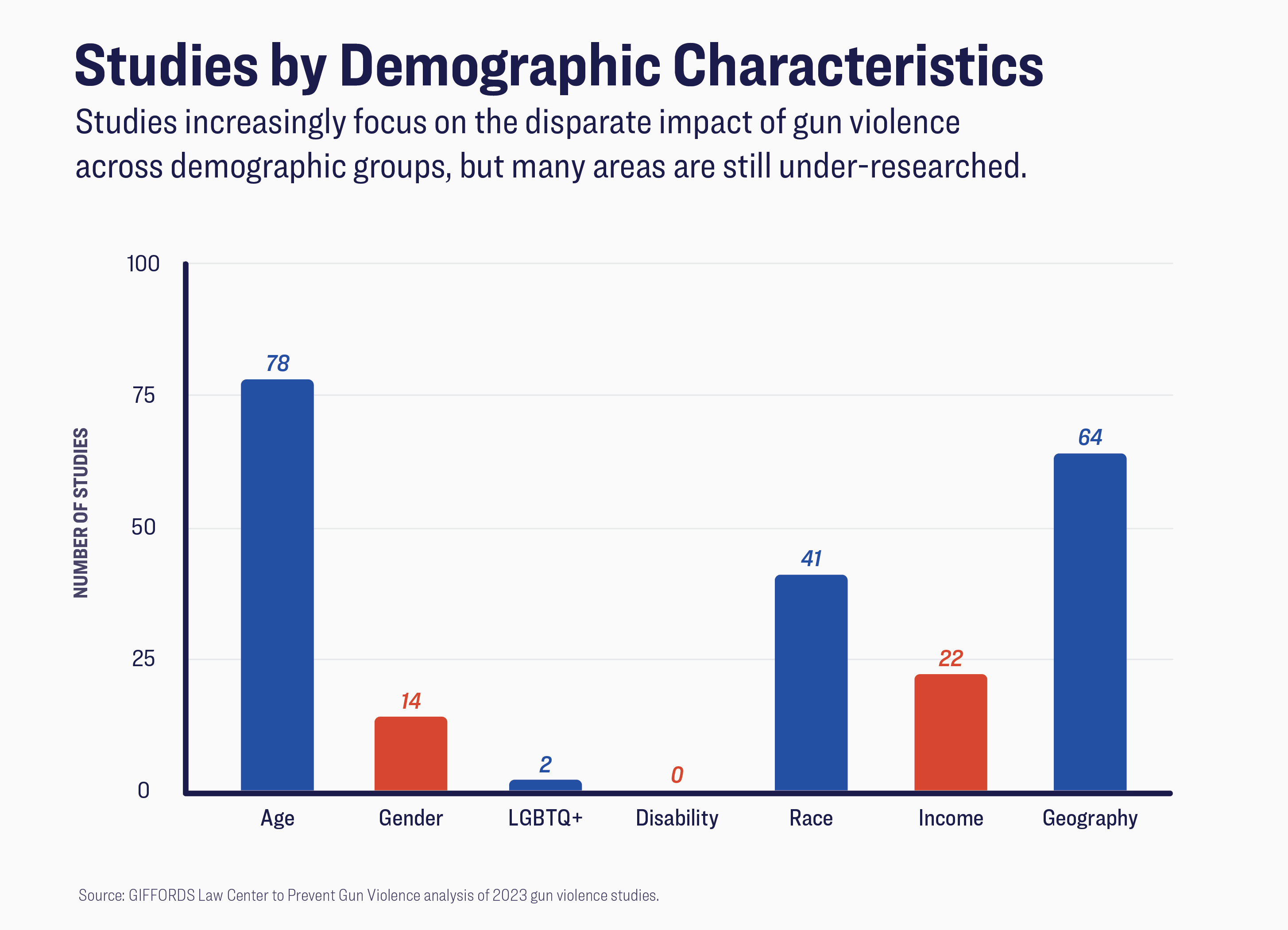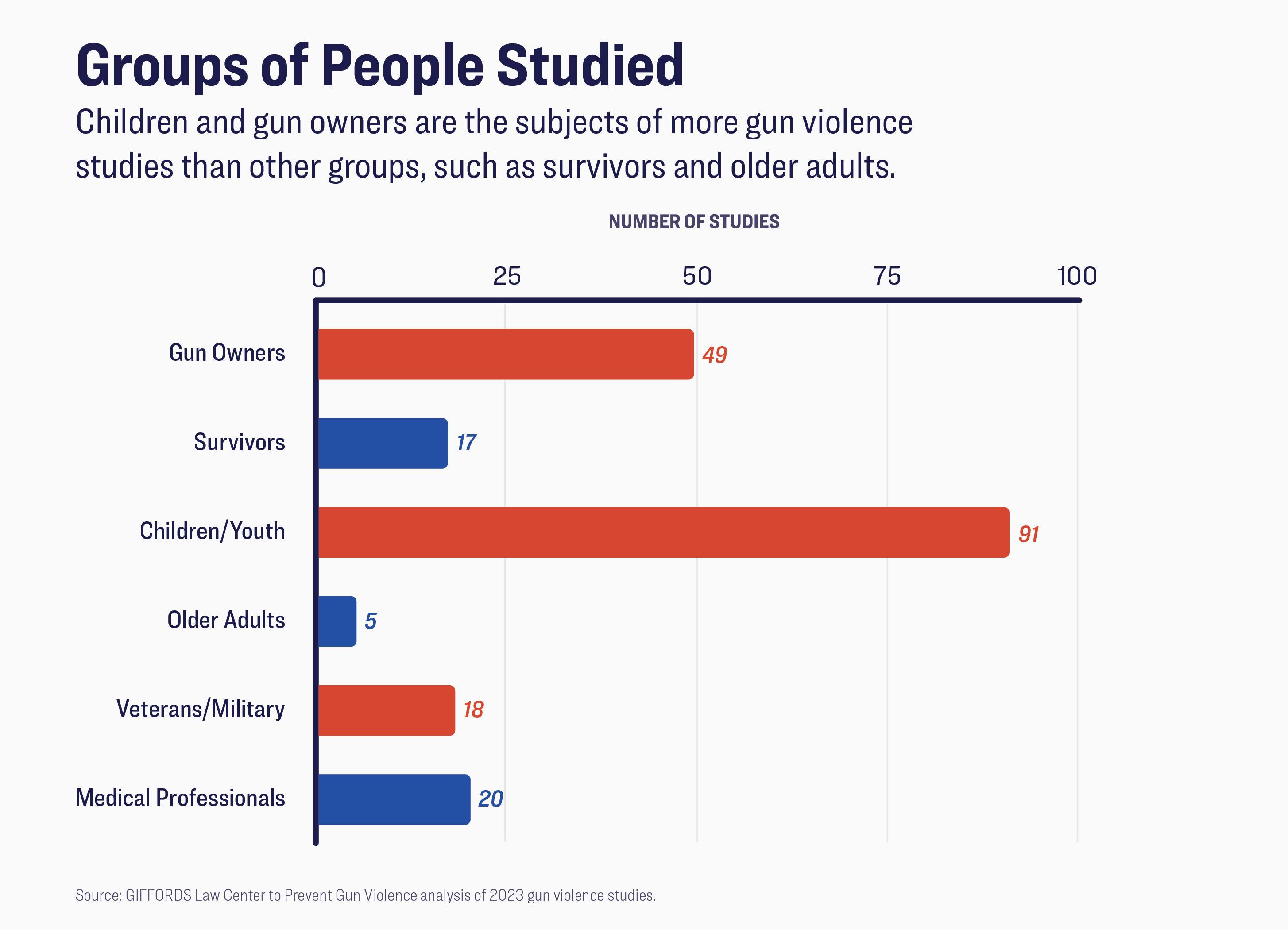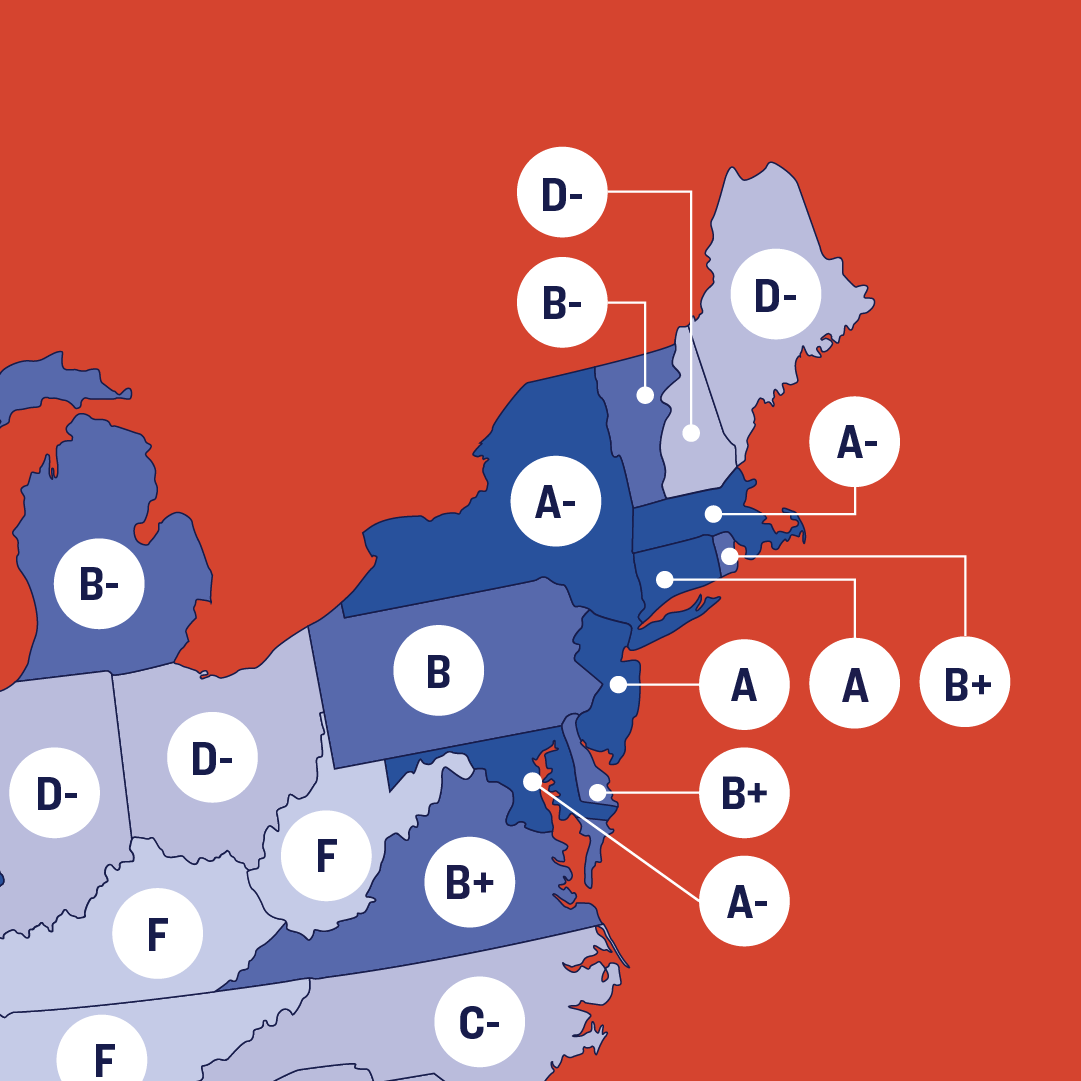
Gun Violence Research Roundup
The field of gun violence prevention research is growing, but too many gaps still exist—preventing solutions from being adopted and implemented to save lives.
To make our communities safer, we must understand the causes of gun violence so that we can develop effective policies to reduce it.
In order to do so, we must have the resources to adequately research gun violence—a struggle the field has faced in recent decades. But new federal investments in this research have allowed for more comprehensive studies into gun violence and the effectiveness of gun safety policies. As the research field begins to grow once more, we must be vigilant about what these new studies focus on.
For years, researchers interested in studying the causes, consequences, and prevention of gun injury were stymied by severe restrictions on federal funding created after a congressional rider, known as the Dickey Amendment, was included in an appropriations bill in 1996.
The consequences of the federal funding freeze were severe. A 2017 study found that gun violence research receives less than 2% of the federal funding it would be expected to receive based on the scope and toll of the problem.1 This study also found that the volume of research publications on gun mortality was just 4.5% of what would be expected based on publication volume for other leading causes of mortality.2
Research Roundup: An Analysis of Gun Violence Publication Trends in 2021
Alex Nguyen, Kelly Drane—Feb 08, 2022
Fortunately, in recent years, there has been an influx of funding to study this urgent public health issue. After years of advocacy from gun violence prevention researchers, public health professionals, and advocates, in 2019, Congress appropriated $25 million to be split between the Centers for Disease Control and Prevention (CDC) and National Institutes of Health (NIH) to provide increased opportunity to rigorously study this growing public health epidemic. This funding has been reauthorized in the following four congressional budgets—for a total of $125 million appropriated since Fiscal Year 2020.
This federal funding has already been used to fund more than 60 gun violence prevention projects and data collection efforts, the results of which have begun to emerge in new academic research publications. Critically, there is also reason to believe that this increased federal funding will have benefits beyond simply the studies funded: One recent study found that increased federal funding was associated with more gun violence research publications, including publications that did not report federal funding.3 The study authors speculate that federal funding may serve as a motivator and legitimator that increases the availability of other funding sources and attracts researchers to the field.
States have also recognized the importance of gun violence research for their own prevention efforts—in some cases stepping in to support this research when the federal government would not. Several states—California, New Jersey, and Washington—have established firearm violence research centers that operate with state funding. Other states, like Colorado, have created offices of gun violence prevention that closely collaborate with public research institutions in the state.
MEDIA REQUESTS
Our experts can speak to the full spectrum of gun violence prevention issues. Have a question? Email us at media@giffords.org.
Contact
This new funding is critical, but there are still decades of lost research to make up for. One recent report estimated that it will cost between $587 and $639 million over five years—or roughly $117 to $128 million annually—for the federal government to fully implement a comprehensive plan to close the gun violence information gap.4
With this new focus on gun violence research, stakeholders have made many calls for how and where funding should be spent. Starting in 2019, NORC at the University of Chicago began a project to evaluate gaps in gun violence data collection infrastructure.5 This project culminated in a report that included 13 action items for the federal government, including improving the timeliness of federal data and better tracking non-fatal firearm injuries.6 In 2020, the Joyce Foundation released a report outlining 100 key questions across 10 different issue areas that a comprehensive gun violence research agenda should address.7
These reports provide important information to guide research priorities in the gun violence prevention field, but it is also important to consider the focus of current scientific attention. Actionable information on what has been studied and what has yet to be studied is critical to guiding efforts to use these funds effectively. Starting in 2021, GIFFORDS Law Center began a first-of-its-kind tracking of the gun violence research landscape. This tracking allows us to identify trends in gun violence research publications, to better understand areas of current scientific attention, and to identify gaps that warrant further analysis—and additional resources—going forward. The following report focuses on trends in gun violence publications in 2023, with references to 2021 and 2022 tracking data for comparison, and we offer recommendations to further strengthen the gun violence research field:
- Increase overall funding for gun violence research.
- Improve gun violence data collection.
- Prioritize gun violence prevention policy and program evaluations.
- Create more community-research partnerships.
- Make the field of research more accessible.

SPOTLIGHT
GUN VIOLENCE STATISTICS
Explore facts, figures, and original analysis compiled by our experts. To end our gun violence crisis, we need to better understand where, how, and why violence occurs.
Learn MoreResearch articles for this analysis were identified using Google Scholar and PubMed alert systems. Search terms included firearm- and firearm violence–related terms (e.g., gun, firearm, gun violence, homicide, suicide, shooting) along with various terms related to specific gun violence prevention policies and programs (e.g., universal background check, extreme risk protection order, stand your ground, violence intervention). Additional articles were identified through gun violence prevention related news sources, gun violence prevention organization newsletters, and from direct contact with gun violence prevention researchers.
Our analysis considered articles that both (1) were published or made available in a peer-reviewed journal in 2023 and (2) provided novel scientific analysis related to the causes, consequences, characterization, or prevention of firearm violence and injury in the United States. Our analysis excluded non-empirical articles, including commentaries, review articles, and articles that only discussed theory without novel data analysis. Medical case studies describing the medical pathology or management of specific gunshot wounds were also excluded. Additionally, we excluded from our sample articles published in non-peer reviewed sources, including intramural federal and state government reports and articles. Articles published in 2023 but identified after January 5, 2024, were not included in the analysis.
Our final analytic sample consisted of 429 eligible articles. To systematically identify the topics and themes of these articles, we created a database consisting of more than 80 fields pertaining to the type of gun violence covered in the article (homicide, suicide, etc.); the main area of focus of the article (gun violence, gun policy, gun violence prevention program, etc.); and other relevant characteristics including the types of risk factors evaluated, the geographic unit of analysis, and the methodology of the article. We then coded each article in the database and generated descriptive statistics.
Brief descriptions of some of the reviewed articles are included as examples within our analysis. These descriptions are not meant to summarize all research findings from the selected studies, and not all studies reviewed in our analysis were included as example studies.
Below, we highlight trends in gun violence research in 2023 and identify gaps that warrant further resources.
Number of Studies
In 2023, we identified 429 research articles published on gun violence or gun violence prevention—similar to the 493 articles identified in 2021 and 415 articles identified in 2022.
Types of Gun Violence Studied
Gun violence in the US takes many different forms—including gun suicides, gun homicides, police shootings, and unintentional shootings—and often impacts people differently based on who they are and where they live. Having actionable research on all types of gun violence is critical for understanding how we can address this issue in all its forms.
The majority of studies (76%) published in 2023 focused on or provided specific analysis related to at least one form of gun violence. Some studies examined two or more forms of gun violence, with these multi-focused articles most commonly studying both gun homicide and gun suicide.

More than one-third (34%) of studies that focused on at least one form of gun violence provided findings on interpersonal gun violence, including gun homicides and gun assaults. Articles on interpersonal violence were twice as common as articles focusing on gun suicide—even though gun suicides make up the majority of US gun deaths.8 A smaller number of studies focused on unintentional shootings (4.2%) or police shootings (3.7%). Just four articles—equivalent to less than 1% of studies—focused on firearm hate crimes or extremism involving firearms.
Our review found that of articles that provided specific study of gun homicides, a roughly equal number focused on mass shootings (29%) and community gun violence (21%), despite the fact that community violence accounts for a far greater percentage of gun deaths and injuries each year. A smaller number of articles focused on domestic violence (8.2%).
Importantly, these disparities in publications by gun violence intent type are not markedly different than we observed in 2021 and 2022, with interpersonal violence–focused articles continuing to outpace suicide-focused articles across all three years. Additionally, compared to articles on mass shootings, community violence–focused studies have represented a smaller share of interpersonal violence–related articles in both 2022 and 2023, despite the fact that community violence–related shootings far outpace mass shooting deaths and injuries.

However, one promising trend we observed in 2023 was an increasing share of articles focused on nonfatal gun violence. In both 2021 and 2022, we found that research on gun violence by intent type overwhelmingly focused on gun deaths, rather than gun injuries or other forms of firearm-related harm, with just 7% and 10% of articles in these years, respectively, analyzing nonfatal shootings. Importantly, a growing share of 2023 articles, 19%, provided analysis of nonfatal shootings. Although this improvement is promising, national databases suggest that nonfatal shootings are twice as common as fatal shootings, indicating that nonfatal gun violence is still understudied. Limited availability and quality issues with nonfatal shooting data at both the national and state level have been well-documented9 and appear to impede efforts to more specifically study this aspect of the gun violence epidemic.
Outcomes Studied
To understand trends in evaluated outcomes, we grouped articles into two broad categories of “problem-focused” articles and “solution-focused” articles. These distinctions were based on the four step CDC model of violence as a public health issue, which includes (1) defining the problem, (2) identifying risk and protective factors, (3) developing and testing prevention strategies, and (4) assuring widespread adoption of effective injury prevention principles and strategies. We considered problem-focused studies to be those in the first two steps of that model, such as studies that described the problem of gun violence in terms of its trends and patterns or identified risk and protective factors for gun violence. Solution-focused studies were those that looked at policy or programmatic means to prevent gun violence or the dissemination or implementation of those policies or programs.
Problem-Focused Studies
Many studies (41%) in our review were focused on describing the problem of gun violence and the factors that impacted the likelihood of gun violence occurring. Among these studies, roughly two-thirds (66%) evaluated the nature, dynamics, or trends of gun violence or a specific type of gun violence. Many problem-focused research studies (28%) also explored factors that modify risk for gun violence offending or victimization. Relatively similar trends were observed in 2021 and 2022, where 70% and 46%, respectively, of studies were focused on describing the problem of gun violence, with the bulk (30% and 54%, respectively) of those studies evaluating the nature, dynamics, or trends of gun violence or a specific type of gun violence and a smaller percentage of articles focusing on risk factors for gun violence (26% and 39% in 2021 and 2022, respectively).
Researchers also produced new scholarship on the impact of gun violence beyond deaths and injuries. A number of problem-focused studies (10%) looked at the non-injury or post-injury consequences of gun violence, such as the impact of gun violence on mental health and the financial cost of gun violence. This number is similar to the proportion of such studies in 2022 (9%), but lower than the proportion in 2021 (19%).
Solution-Focused Studies
As seen in the previous two years, a comparatively smaller number of articles provided study of gun violence solutions, including gun safety policies and programs. Only 15% of 2023 studies involved analysis of policies intended to prevent gun violence, similar to the 2021 and 2022 proportions of 18% and 19%. The majority of 2023 policy studies evaluated policy attitudes, policy implementation, or other descriptive measures related to policy.
Only a small fraction of studies that examined policy or programmatic means to prevent gun violence evaluated the impact of these solutions on gun injuries or deaths. In fact, less than 5% of reviewed studies were classified as policy evaluations that measured the impact of gun policy on violence. This number does not differ substantially from the percent of policy evaluation studies in 2021 (3%) or 2022 (7%).

Of these policy evaluation studies, the majority (94%) examined the impact of combined gun policies, such as the overall number of gun policies or a gun law strength score, on gun violence. Of policy evaluation studies that evaluated the impact of a specific policy or policies, the most common types were evaluations of public carry laws (30%)—including permitless carry, campus carry, and other laws which allow civilians to carry guns in public spaces. As observed in previous years, the vast majority (90%) of policy evaluation studies found protective benefits of gun safety laws in preventing gun deaths.
Compared to policy-focused studies, a slightly smaller number (12%) of 2023 studies focused on programmatic means to prevent gun violence—lower than the 16% of studies in 2021, but comparable to the number identified in 2022 (12%). The majority of programmatic studies analyzed firearm safety education programs, firearm suicide prevention programs, or safe storage programs.
Importantly, despite historic investments in community violence intervention strategies across the country, the number of studies focused on community violence intervention strategies has remained stable across all years. In fact, in 2023, we found just 12 articles that examined community violence intervention strategies, representing less than 3% of all articles coded.
Factors of Analysis
A number of 2023 studies were designed specifically to look at differences in experience or outcomes along the lines of demographic characteristics or socioeconomic status. Studies that pose a central question as to how outcomes differ across different social and demographic characteristics are critical for understanding disparities in gun deaths and making equitable policy decisions. While many studies considered demographic or socioeconomic factors within the analysis, a number of studies considered factors of age, race, gender, sexual orientation, disability, income, or geography as specific features of the research question. However, there are large discrepancies in how often each of these particular factors are studied. For example, while 78 studies asked a specific research question about how age related to gun violence risk or exposure, only two studies asked a specific research question about gun violence and LGBTQ+ populations. No studies examined gun violence risk among people with disabilities.

Groups of People Studied
Research suggests that there are a number of people who may experience gun violence differently or uniquely because of their demographic or lifestyle characteristics, such as children and older adults, as well as many groups of people who can play a particularly important role in gun violence prevention, such as medical care providers. Some groups, such as gun owners, may both face increased risk of gun violence and have the potential to play an important role in gun violence prevention. As in 2021 and 2022, we found that gun violence research in 2023 involved some study of many of these groups of interest, but there were key differences in the frequency at which these groups were represented.

For example, in 2021, there were nearly 10 times as many articles published on children and youth compared to older adults. This disparity was much sharper in both 2022 and 2023, with nearly 20 times as many articles published on children and youth compared to older adults (21% vs. 1.2% of all 2023 articles).
Only 11% of articles provided specific focus on gun owners in 2023, and just 4.2% provided focus on veterans, who are often considered an important subset of gun owners, particularly given their heightened risk for firearm suicide. Both of these percentages were higher than observed in 2022 (10% and 2.7%, respectively), but lower than observed in 2021 (16% and 4%, respectively). Gun owner–focused articles tracked in 2023 provided new findings about the characteristics of gun owners, both related to their demographics and their behaviors around acquisition and storage. Articles focused on veterans examined their unique relationship with firearms and the risk of firearm suicides among this group.
Medical providers also received substantial study—with articles studying this group accounting for 4.7% of all 2023 articles. Many clinician-focused studies examined their role in firearm violence prevention programs, particularly those related to suicide and youth violence prevention.
Methods of Studies
The majority (75%) of published 2023 studies were purely quantitative; just 14% were purely qualitative. Only a handful of studies (10%) were considered to use mixed methods approach. The proportion of studies using a mixed methods approach was more than double in 2023, compared to 2021 and 2022.
An extremely limited number of studies (2.3%) engaged community members in the research process. Similarly small proportions of such studies were seen in 2021 and 2022 (1.4% and 2.7%, respectively). Across all years, we have seen a number of studies about certain groups of people, such as people living in communities with high rates of violence or gun owners, but extremely few studies conducted with members from these groups or other non-researchers. In fact, in the last two years, we have tracked no studies that engaged gun owners or survivors of any forms of gun violence. The few studies that did employ a community-researcher partnership or stakeholder-researcher partnership were all studies related to community violence intervention programs.
Research Field
Our research tracking and review provides important information about the topics covered in gun violence–related research, but our collection of these articles also revealed important findings about the state of the gun violence prevention research field. For example, our review found that almost 1,800 individual researchers were listed as authors on the 429 studies we tracked. This number was higher than seen in 2022, where we identified more than 1,500 unique authors. While a number of authors were published several times, this analysis underscores the growing depth of this field and the number of individuals from diverse disciplines who undertook scholarship on firearm violence in 2023.

Many of these researchers with numerous publications were housed within one of the three state-funded research centers in operation in 2023. These centers—in California, New Jersey, and Washington—continue to serve as critical centers for scholarship on gun violence and gun violence prevention, with nearly 15% of all the research studies in our sample coming from just these three centers. These centers were responsible for 15% of all studies in our sample in 2021 and 14% in 2022. Not only do these centers produce research that is of interest nationally, but there is also evidence that state-funded research centers can provide specific and actionable research on gun violence in their state. In fact, of studies that examined gun violence in a particular state, California and Washington were the most and second-most frequently studied. Half of the studies in these two states were conducted by researchers at one of the respective state research centers.
In addition to state funding, federal and other governmental funding played a critical role in promulgating gun violence research in 2023. Nearly a third (33%) of articles listed government sources of funding support—either for the research project or the researcher. This is up from 22% in 2022. Importantly, some of the new research published in 2023 included research made possible by recent congressional appropriations for gun violence research.
In our tracking, we also noted that a growing number of articles are available on open-access, meaning that they are free of cost and other barriers. In fact, 44% of 2023 articles were available on open-access, up from 32% in 2021 and 39% in 2022, showing a promising shift in the accessibility of this important research.

The field of gun violence research is changing, as evidenced by hundreds of new publications each year, more researchers entering the field, and more federal money than ever being spent to understand and identify solutions to this problem. But there are still substantial gaps and disparities in this field. It is critical that the gun violence research field produces equitable, actionable research so that policymakers and advocates can best address this crisis. The following recommendations outline the most urgent steps that should be taken to strengthen the research field, as evidenced by our review of this research over the past three years.
Increase overall funding for gun violence research
There is no doubt that the amount of funding available for gun violence research has risen dramatically in recent years. This funding has helped to create a field where nearly 1,800 scholars had the opportunity to produce more than 400 high-quality original research studies on gun violence in a calendar year. And while all of this new work is critically important to our efforts to understand and address this issue, we know that there are still topics within this field that receive too little study or no study at all, and that the number of publications on this issue pales in comparison to publications on other leading causes of death.
It is critical that funders and policymakers create an environment that fosters a strong research response to this public health crisis. As a next step, we encourage Congress to include at least $25 million for gun violence research in the Consolidated Appropriations Act of Fiscal Year 2025—the same amount included in both House and Senate FY2025 appropriations bills and the amount requested by President Biden. Furthermore, we recommend that additional state, local, and private funders dedicate new monies to promulgate new gun violence research, either by expanding existing grant programs or creating new ones.
States in particular should also work to create state-funded gun violence research centers. In the last three years, more than one in seven gun violence studies were produced by scholars at one of the three state-funded research centers, and research produced by these centers often provided state-specific information relevant to policymaking or implementation efforts. States should explore additional options to create centralized state research centers at academic universities to generate further scholarship on gun violence and gun violence prevention.
Improve gun violence data collection
Deficiencies in our data collection systems make it incredibly challenging for researchers to define and study the nuanced contours of gun violence in America. For example, our nation’s tracking of nonfatal firearm injuries is woefully inadequate, with many sources of this data subject to incomplete reporting or poor coding of injury intent. Accordingly—and unsurprisingly—we identified relatively few studies that examine this important aspect of the gun violence epidemic. Similarly, information about the LGBTQ+ and disability status of gun violence victims is not uniformly collected in our national mortality systems, partially explaining why we saw extremely limited scholarship over the past year that asked a primary research question about how these factors intersect with gun violence.
Improving collection of firearms data will require increased investments, particularly at the federal level. Fortunately, there are promising programs in the works. In 2020, the CDC awarded funding to 10 state health departments to capture near-real-time data on emergency visits for nonfatal firearm injuries through a program now known as Advancing Violence Epidemiology in Real-Time (AVERT). Dashboards with this data have already been created in some states, and the near-real-time tracking is already being used to make concrete decisions about program work in these states. Additional federal funding for gun violence research at the CDC could help expand this program—as well as other data collection programs—to more states.
Prioritize gun violence prevention policy and program evaluations
In 2023, we continued to see an imbalance of studies describing the problem of gun violence versus the solutions to it. More concerningly, an even smaller number of solution-focused studies evaluated the impacts of specific programs and policies on gun injuries and deaths. Although any research on gun violence is important, solution-focused research is particularly critical to ensuring that research has a direct and immediate impact on efforts to prevent violence. Given the incredibly high burden of our nation’s gun violence epidemic, research that is solution-focused is absolutely critical at this juncture.
Create more community-research partnerships
Science rooted in the power of those most directly impacted helps produce better research: when communities are invited to share in the research design and process, their perspectives can help ensure the relevancy of research questions; increase the capacity of data collection, analysis, and interpretation; and uncover theories that may not be readily apparent to those in the academic community. Too often, we see research about certain groups of people, rather than research conducted in concert with impacted communities. In fact, our review found that community members and those with lived experience served as research partners in only a small handful of studies published in all three years we have reviewed gun violence research publications.
Researchers and funders must prioritize research that equitably partners with community members and includes community perspectives to ensure that future research reflects and incorporates the experiences of those closest to this issue. This work should include research with survivors, people from communities disproportionately impacted by gun violence, gun owners, gun violence prevention practitioners, and other community stakeholders.
Make the field of research more accessible
It is vital that the field of gun violence prevention research is accessible to people outside of academia, including advocates, community stakeholders, practitioners, and policymakers. These actors are largely responsible for designing and implementing solutions to gun violence, and accessible research is critical to guide their efforts and ground solutions in evidence. While we have seen some promising increases in the number of articles available on open access, it is critical that the field continues to improve access to scientific works. Funders should provide specific monies in grants to encourage publication on open access and journals should also waive or reduce fees for publishing work on open access.

SPOTLIGHT
GUN LAW SCORECARD
The data is clear: states with stronger gun laws have less gun violence. See how your state compares in our annual ranking.
Read MoreWhen researchers conduct studies on gun violence and gun policy, they do so not just to satisfy curiosity or advance knowledge. High-quality science grounds high-quality solutions—which in turn saves lives. We’ve seen countless examples of this process, with research playing a critical role in addressing so many public health crises, from car crashes to COVID-19 to underage drinking.
It is encouraging to see the field of gun violence prevention research grow, providing us with new evidence and new ideas. Over our three-year review of published articles, there have been remarkable signs of progress, including an expansion in the number of researchers engaged in this work and an increase in government-supported firearm violence research. However, too many gaps still exist in this field, too many areas remain unstudied, and too many voices and perspectives are missing from the current research landscape. And unfortunately, these gaps can impede and prevent solutions from being adopted and implemented to save lives.
Tackling our gun violence crisis requires a strong and responsive gun violence research field. We hope these results can help researchers, funders, policymakers, and stakeholders as they work to produce more actionable and more equitable research. And in turn, we hope that this new research will form a solid foundation for action.
- David E. Stark and Nigam H. Shah, “Funding and Publication of Research on Gun Violence and Other Leading Causes of Death,” JAMA 317, no. 1 (2017): 84–86.[↩]
- David E. Stark and Nigam H. Shah, “Funding and Publication of Research on Gun Violence and Other Leading Causes of Death,” JAMA 317, no. 1 (2017): 84–86.[↩]
- John C. Lin et al., “Trends in Firearm Injury Prevention Research Funding, Clinical Trials, and Publications in the US, 1985–2022,” JAMA Surgery: 2024.[↩]
- “Cost Estimates of Federal Funding for Gun Violence Research and Data Infrastructure,” Health Management Associates, July 13, 2021, https://assets.joycefdn.org/content/uploads/CostEstimateofFederalFundingforGunViolenceResearch.pdf?mtime=20210712175851&focal=none.[↩]
- Expert Panel on Firearms Data Infrastructure,” NORC at the University of Chicago, last accessed January 11, 2022, https://www.norc.org/Research/Projects/Pages/expert-panel-on-firearms-data-infrastructure.aspx.[↩]
- John K. Roman, “A Blueprint for a U.S. Firearms Data Infrastructure,” NORC at the University of Chicago, October 2020, https://www.norc.org/PDFs/Firearm%20Data%20Infrastructure%20Expert%20Panel/A%20Blueprint%20for%20a%20U.S.%20Firearms%20Data%20Infrastructure_NORC%20Expert%20Panel%20Final%20Report_October%202020.pdf.[↩]
- Ted Alcorn, “The Next 100 Questions: A Research Agenda For Ending Gun Violence,” The Joyce Foundation, December 2020, https://assets.joycefdn.org/content/uploads/TJF-The-Next-100-Questions-A-Research-Agenda-for-Ending-Gun-Violence.pdf?mtime=20210504122403&focal=none.[↩]
- Centers for Disease Control and Prevention, Wide-ranging Online Data for Epidemiologic Research (WONDER), “Underlying Cause of Death, 1999–2020,” last accessed January 3, 2022, https://wonder.cdc.gov/.[↩]
- See, Sean Campbell and Daniel Nass, “The CDC’s Gun Injury Data Is Becoming Even More Unreliable,” The Trace, March 11, 2019, https://www.thetrace.org/2019/03/cdc-nonfatal-gun-injuries-update/.[↩]




